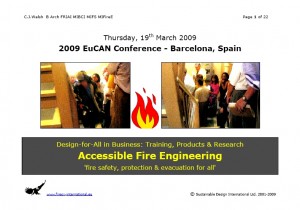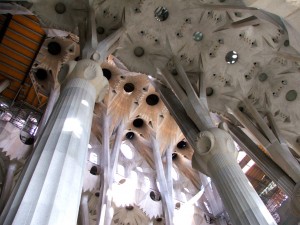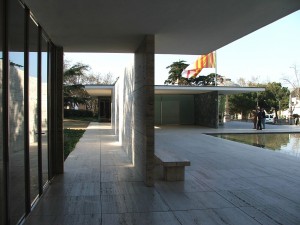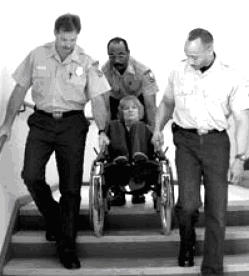2009-03-24: Permit me, first of all, to vigorously reclaim the word ‘accessibility’ back from the Transport Sector. This important conference in Barcelona was not about transport networks or distances from the nearest transportation node … but about Accessibility of the Human Environment for People with Activity Limitations (2001 WHO ICF), i.e. Accessibility-for-All.
A 2-Day Conference organized by EuCAN – the European Concept for Accessibility Network co-ordinated from Luxembourg – it was held in the TRYP APOLO Hotel (Av. Paral-lel, 57-59), on the 19-20th March 2009 … an impressive start-up event for the next EuCAN Project … a publication elaborating the business opportunities being created by Design-for-All for manufacturers and service providers across Europe.
I was very pleased to make a presentation on the exciting business potential of Accessible Fire Engineering … a subset of Sustainable Fire Engineering …

There were, however, some developments at the conference which should be brought to wider public attention for consideration and discussion … here in Ireland, but also in other European countries …

1. News was announced at the conference that the Proposed International Accessibility-for-All Standard (at present ISO CD 21542.3) has been overwhelmingly supported (mid-March 2009) for progress to the Draft International Standard (DIS) stage in its development. If everything goes well, we should see this International Standard being published sometime during the first half of 2010.
The ISO Accessibility-for-All Standard, which will be an essential implementation tool for Articles 9 & 11 of the 2006 United Nations Convention on the Rights of Persons with Disabilities in relation to Buildings, is particularly important for 2 Reasons:
– ‘Fire Safety’ Texts are now included in the Main Body of the Standard ;
– ‘Fire Evacuation’ is fully integrated into the definition and meaning of ‘Accessibility’.

2. A conversation during the conference morning coffee break, on Friday 20th March, with Bojana Rudić and Miodrag Počuč of the Centar Živeti Uspravno in Serbia, has finally convinced me that all of the various Accessibility Design Philosophies …
– design-for-all (some attempts have been made to develop 6 Principles for this rather vague philosophy) … used by EU Institutions, and more widely throughout Europe in reaction to universal design ;
– universal design (with its 7 Principles/Commandments) … preached from the USA … but in Japan, for example, a more practical application can be seen. Strangest of all is the relatively recent establishment in Ireland of the Centre for Universal Design, within the lumbering qwango that is the National Disability Authority (NDA) ;
– inclusive design (with its 5 Principles) … originating from Great Britain ;
– barrier-free design (a philosophy long out of date) … still widely referred to in Germany and other parts of Central Europe ;
– facilitation design (a newer philosophy based on 2 WHO ICF Terms: ‘Facilitator’ and ‘Environmental Factors’ and intended to update barrier-free design) … not yet well known ;
… are not only causing enormous confusion about accessibility among the ‘un-initiated’ and architectural students, to take just two examples … but are diverting scarce resources away from the process of ‘real’ accessibility implementation.
In some cases, devotion to these philosophies is so consuming that I have experienced, first-hand, a general tendency to discourage any talk about rights … with some prominent members of the International Accessibility Community (who shall remain nameless !) not even bothering to read the actual text of the 2006 UN Disability Rights Convention !

3. Concerning the development of a European Accessibility Business Strategy …
– 2006 UN Convention on the Rights of Persons with Disabilities
Yes … Accessibility-for-All is about much more than making life and living easier for people with disabilities. Children, frail older people (not all older people !), women in the later stages of pregnancy, people who have a health condition, etc., all now need to be included in a more Person-Centred Approach to the design and sustainable transformation of our Human Environment. This is absolutely essential.
But … the 2006 UN Convention must be used as a Product & Service Checklist which covers the basic, i.e. minimum, responsible needs of people with disabilities … a sizeable social group in all of our societies. Failure to complete this simple task is a fundamental strategic error !
The 2006 UN Convention on the Rights of Persons with Disabilities is also their sole route of access to the human and social rights set down in the 1948 Universal Declaration of Human Rights.
– Integration of Accessibility-for-All Performance
Building Accessibility, to take a specific example, is now more complex … and includes …
– Approach to the building from the site boundary ;
– Entry through principal entrance(s) ;
– Health, Safety, Convenience & Comfort In Use, including thermal and acoustic comfort, good indoor air quality, protection from fire, etc ;
– Egress under normal conditions ;
– Evacuation in the Event of a Fire, or other emergency ;
– Removal from the vicinity of the building back to the site boundary ;
and …
– Each stage of a Work Process, at every level, in places of work ;
– Use of Electronic, Information & Communication Technologies (EICT’s) – at minimum, those permanently fixed in/to the building ;
and …
– Management, Services & Attitudes of People in the organization using the building ;
– Recruitment, Employment, Promotion & Training Practices within the same organization.
Performance in all of these different, and up until now separate, components must be brought together and properly integrated.
– Accessibility-related Products
In Ireland, we suffer from an over-supply of British manufactured accessibility-related products which are badly-designed and inadequately tested … or not tested at all. Inability to show compliance with Part D of the Irish Building Regulations is a big issue … that is, if those manufacturers even realize that we have our own separate building legislation over here.
By the way, failure to be able to show compliance with Regulation 7 of the Building Regulations for England & Wales is an issue across the water as well !
The situation isn’t much better in the rest of Europe. Yes … the quality of design is much, much better, but there is still enormous confusion about CE Marking.
Accessibility-related Products are still, and always have been, industrial products which are being placed on the Single European Market. Normal rules apply !
– Accessibility-related Services
Hopefully, we will soon see the demise of the Access Consultant … a plentiful species, particularly in Great Britain … an individual who only deals with ‘approach to’, ‘entry’ and ‘use’ of a building or facility … and nothing about ‘fire evacuation’. Their days are slowly numbered !
The rest of us, however, need to familiarize ourselves with necessary new services …
– Accessibility Impact Assessment ;
– Accessibility Performance Indicators ;
– Accessibility Benchmarking, Target Setting and Progress Evaluation ;
– Independent Accessibility Verification ;
– Etc.
Accessibility-related Services must be dragged out of prehistoric caves … screaming, if necessary. Services must become much more professional !
.
.
END



